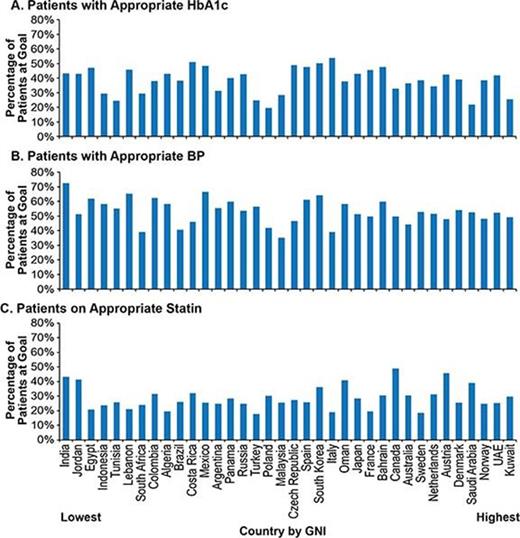-
PDF
- Split View
-
Views
-
Cite
Cite
A Malik, H Chen, A Cooper, M Gomes, V Hejjaji, L Ji, K Khunti, M Kosiborod, A Nicolucci, P Peri-Okonny, M Shestakova, F Tang, J Vora, H Watada, S Arnold, Relationship between country income, socioeconomic factors and control of cardiovascular disease risk factors in patients with type 2 Diabetes: insights from the global DISCOVER registry, European Heart Journal, Volume 41, Issue Supplement_2, November 2020, ehaa946.2832, https://doi.org/10.1093/ehjci/ehaa946.2832
Close - Share Icon Share
Abstract
In patients with type 2 diabetes (T2D), optimal management of cardiovascular (CV) risk factors is critical for primary prevention of CV disease.
To describe the association of country income and patient socioeconomic factors with risk factor control in patients with T2D.
DISCOVER is a 37-country, prospective, observational study of 15,983 patients with T2D enrolled between January 2016 and December 2018 at initiation of 2nd-line glucose-lowering therapy and followed for 3 years. In patients without known CV disease with sub-optimally controlled risk factors at baseline, we examined achievement of risk factor control (HbA1c <7%, BP <140/90 mmHg, appropriate statin) at the 3 year follow-up. Countries were stratified by gross national income (GNI)/capita, per World Bank report. We explored variability across countries in risk factor control achievement using hierarchical logistic regression models and examined the association of country- and patient-level economic factors with risk factor control.
Among 9,613 patients with T2D but without CV disease (mean age 57.2 years, 47.9% women), 83.1%, 37.5%, and 66.3% did not have optimal control of glucose, BP, and statins, respectively, at baseline. Of these, 40.8%, 55.5%, and 28.6% achieved optimal control at 3 years of follow-up. There was substantial variability in achievement of risk factor control across countries (Figure) but no association of country GNI/capita on achievement of risk factor control (Table). Insurance status, which differed substantially by GNI group, was strongly associated with glycemic control, with no insurance and public insurance associated with lower odds of patients achieving HbA1c <7%.
In a global cohort of patients with T2D, a substantial proportion do not achieve risk factor control even after 3 years of follow-up. The variability across countries in risk factor control is not explained by the GNI/capita of the country.
Association of factors with achievement of risk factor control at year 3 among patients not at control at baseline
| . | HbA1C <7% (OR 95% CI) . | BP <140/90 mm of Hg (OR 95% CI) . | Appropriate Statin (OR 95% CI) . |
|---|---|---|---|
| Country-Level GNI/Capita (Ref: High Tertile) | |||
| Middle Tertile | 1.06 (0.66–1.69) | 1.02 (0.66–1.59) | 0.69 (0.40–1.21) |
| Lower Tertile | 1.06 (0.69–1.63) | 1.38 (0.91–2.10) | 0.72 (0.42–1.25) |
| Selected Patient-Level Socioeconomic Factor: Insurance (Ref: Private) | |||
| None | 0.64 (0.51–0.80) | 0.89 (0.66–1.22) | 1.83 (1.11–3.04) |
| Public | 0.76 (0.61–0.94) | 1.01 (0.76–1.35) | 1.05 (0.69–1.62) |
| . | HbA1C <7% (OR 95% CI) . | BP <140/90 mm of Hg (OR 95% CI) . | Appropriate Statin (OR 95% CI) . |
|---|---|---|---|
| Country-Level GNI/Capita (Ref: High Tertile) | |||
| Middle Tertile | 1.06 (0.66–1.69) | 1.02 (0.66–1.59) | 0.69 (0.40–1.21) |
| Lower Tertile | 1.06 (0.69–1.63) | 1.38 (0.91–2.10) | 0.72 (0.42–1.25) |
| Selected Patient-Level Socioeconomic Factor: Insurance (Ref: Private) | |||
| None | 0.64 (0.51–0.80) | 0.89 (0.66–1.22) | 1.83 (1.11–3.04) |
| Public | 0.76 (0.61–0.94) | 1.01 (0.76–1.35) | 1.05 (0.69–1.62) |

Proportion of patients at goal
Type of funding source: Private company. Main funding source(s): The DISCOVER study is funded by AstraZeneca



